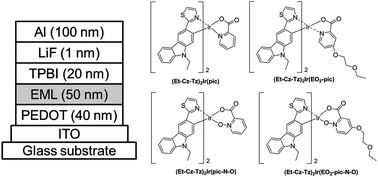A new series of highly efficient phosphorescent Ir(III) complexes, which have potential applications in solution processable phosphorescent organic light-emitting diodes (PhOLEDs), were synthesized and their photophysical, electrochemical, and electroluminescent (EL) properties were investigated. The Ir(III) complexes, including (Et-Cz–Tz)2Ir(pic), (Et-Cz–Tz)2Ir(pic-N-O), (Et-Cz–Tz)2Ir(EO2–pic), and (Et-Cz–Tz)2Ir(EO2–pic-N-O), are comprised of linked N-ethylcarbazole (Et-Cz) and thiazole (Tz) units as the main ligand (Et-Cz–Tz) and picolinic acid (pic) and picolinic acid N-oxide (pic-N-O) as ancillary ligands. In addition, some of the Ir(III) complexes contain an ethylene oxide solubilizing group attached to the ancillary ligands via a tandem reaction. High performance, solution processable PhOLEDs, fabricated using (Et-Cz–Tz)2Ir(EO2–pic), were observed to have a maximum external quantum efficiency of 6.08% and a luminance efficiency of 10.98 cd A−1. This is the first report on the use of EO2–pic and EO2–pic-N-O ancillary ligands for the synthesis of solution processable Ir(III) complexes via a tandem reaction. The performances of the PhOLEDs based on these Ir(III) complexes correlate well with the theoretical properties predicted by using density functional theory calculations.

